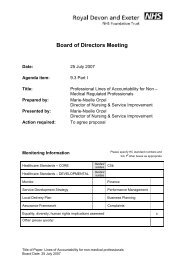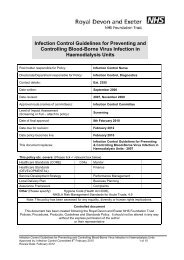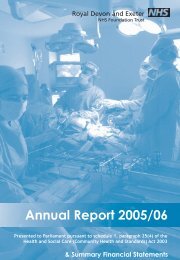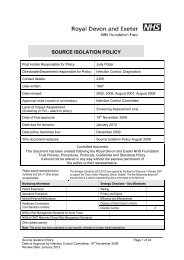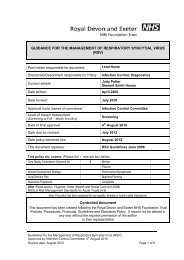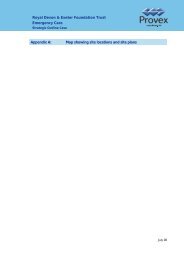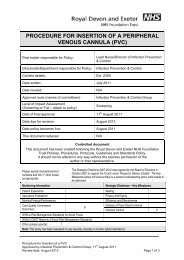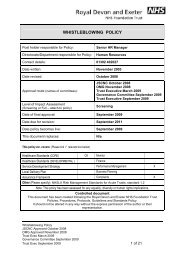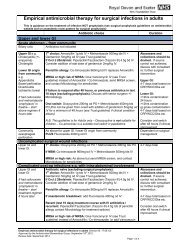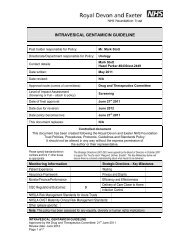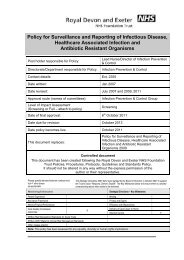Annual Report and Accounts 2012/13 - Royal Devon & Exeter Hospital
Annual Report and Accounts 2012/13 - Royal Devon & Exeter Hospital
Annual Report and Accounts 2012/13 - Royal Devon & Exeter Hospital
You also want an ePaper? Increase the reach of your titles
YUMPU automatically turns print PDFs into web optimized ePapers that Google loves.
1. ACCOUNTING POLICIES (CONTINUED)<br />
1.12 Critical accounting estimates <strong>and</strong> judgements<br />
In the application of the Trust’s accounting policies, management is required to make judgements, estimates <strong>and</strong><br />
assumptions about the carrying amounts of assets <strong>and</strong> liabilities that are not readily apparent from other sources.<br />
The estimates <strong>and</strong> associated assumptions are based on historical experience <strong>and</strong> other factors that are<br />
considered to be relevant. Actual results may differ from those estimates <strong>and</strong> the estimates <strong>and</strong> underlying<br />
assumptions are continually reviewed.<br />
Accounting judgement - Modern Equivalent Asset valuation<br />
The majority of the Trust's estate is considered to be specialised assets as there is no open market for an acute<br />
hospital. The modern equivalent asset valuation is based on the assumption that any modern equivalent<br />
replacement hospital would be built on an alternative site within the <strong>Exeter</strong> locality.<br />
1.<strong>13</strong> Leases<br />
ROYAL DEVON AND EXETER NHS FOUNDATION TRUST - ANNUAL ACCOUNTS <strong>2012</strong>/<strong>13</strong><br />
Operating leases<br />
Where leases are regarded as operating leases <strong>and</strong> the rentals are charged to operating expenses on a straightline<br />
basis over the term of the lease. Operating lease incentives received are added to the lease rentals <strong>and</strong><br />
charged to operating expenses over the life of the lease.<br />
Leases of l<strong>and</strong> <strong>and</strong> buildings<br />
Where a lease is for l<strong>and</strong> <strong>and</strong> buildings, the l<strong>and</strong> component is separated from the building component <strong>and</strong> the<br />
classification for each is assessed separately.<br />
1.14 Public dividend capital<br />
NOTES TO THE ACCOUNTS<br />
Public dividend capital (PDC) is a type of public sector equity finance based on the excess of assets over liabilities<br />
at the time of establishment of the predecessor NHS trust, the <strong>Royal</strong> <strong>Devon</strong> <strong>and</strong> <strong>Exeter</strong> Healthcare NHS Trust.<br />
HM Treasury has determined that PDC is not a financial instrument within the meaning of IAS 32.<br />
A charge, reflecting the forecast cost of capital utilised by the Trust, is paid over as public dividend capital<br />
dividend. The charge is calculated at the rate set by HM Treasury (currently 3.5%) on the average relevant net<br />
assets of the Trust.<br />
Relevant net assets are calculated as the value of all assets less the value of all liabilities, except for donated<br />
assets <strong>and</strong> cash held with the Government Banking Service. Average relevant net assets are calculated as a<br />
simple means of opening <strong>and</strong> closing relevant net assets in the pre-audit version of the accounts.<br />
1.15 Financial instruments <strong>and</strong> financial liabilities<br />
Recognition<br />
Financial assets <strong>and</strong> financial liabilities which arise from contracts for the purchase or sale of non-financial items<br />
(such as goods or services), which are entered into in accordance with the Trust’s normal purchase, sale or usage<br />
requirements, are recognised when, <strong>and</strong> to the extent which, performance occurs i.e. when receipt or delivery of<br />
the goods or services is made.<br />
All other financial assets <strong>and</strong> financial liabilities are recognised when the Trust becomes a party to the contractual<br />
provisions of the instrument.<br />
De-recognition<br />
All financial assets are de-recognised when the rights to receive cash flows from the assets have expired or the<br />
Trust has transferred substantially all of the risks <strong>and</strong> rewards of ownership.<br />
Financial liabilities are derecognised when the obligation is discharged, cancelled or expires.<br />
Classification <strong>and</strong> measurement<br />
Financial assets are categorised as ‘loans <strong>and</strong> receivables’. Financial liabilities are classified as ‘other financial<br />
liabilities’.<br />
Page 16



